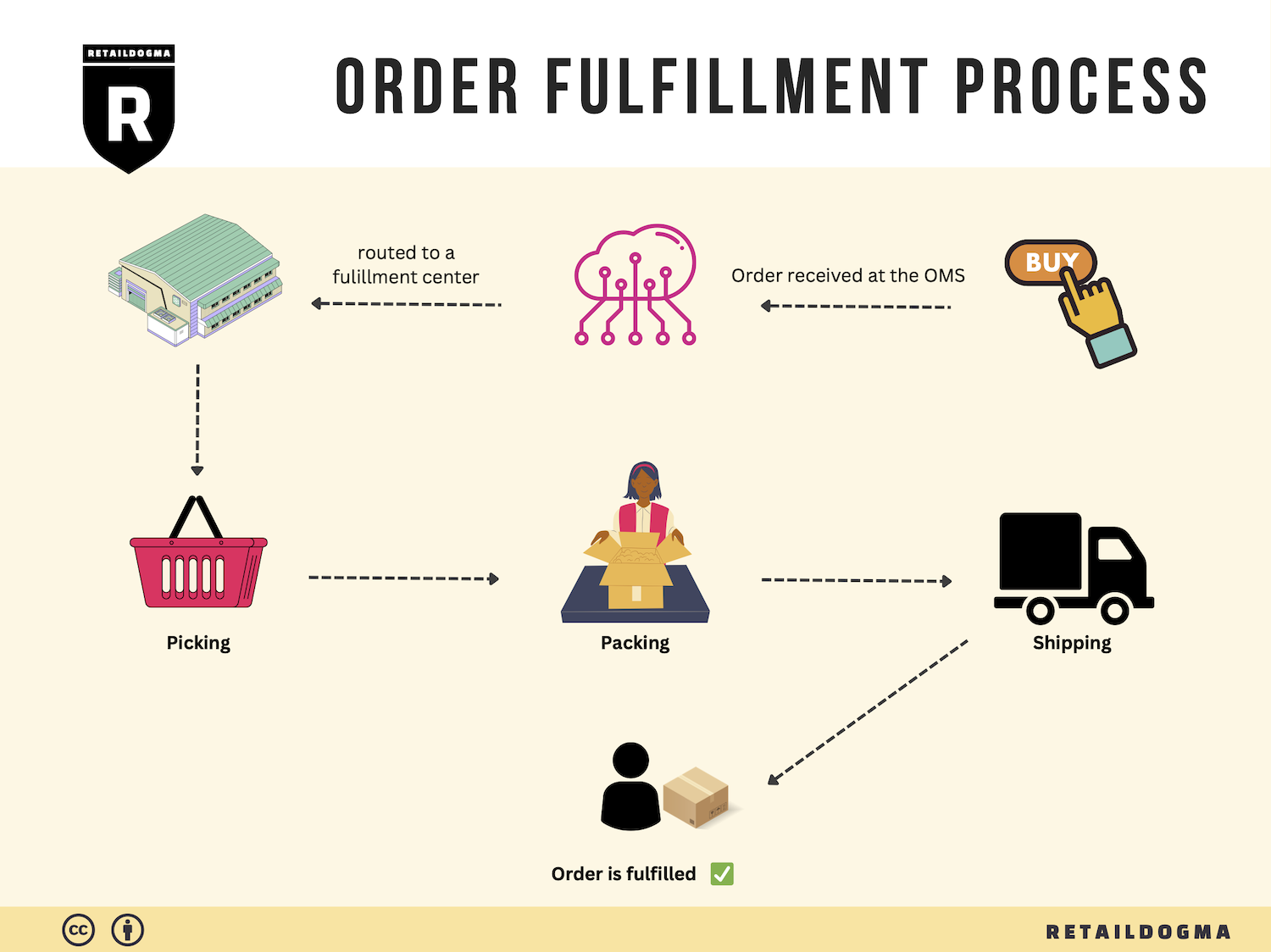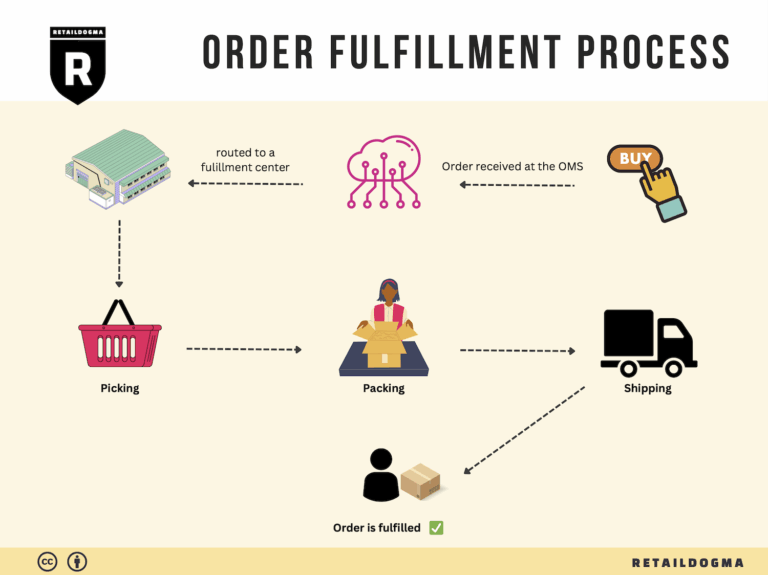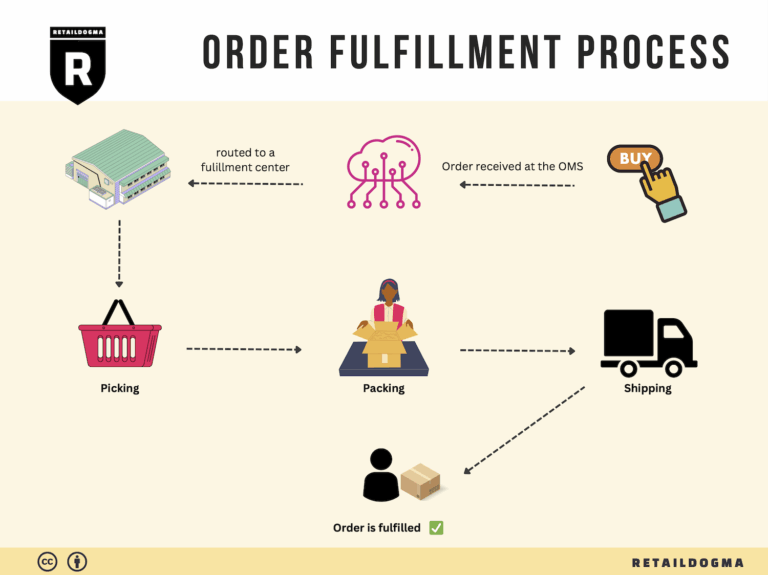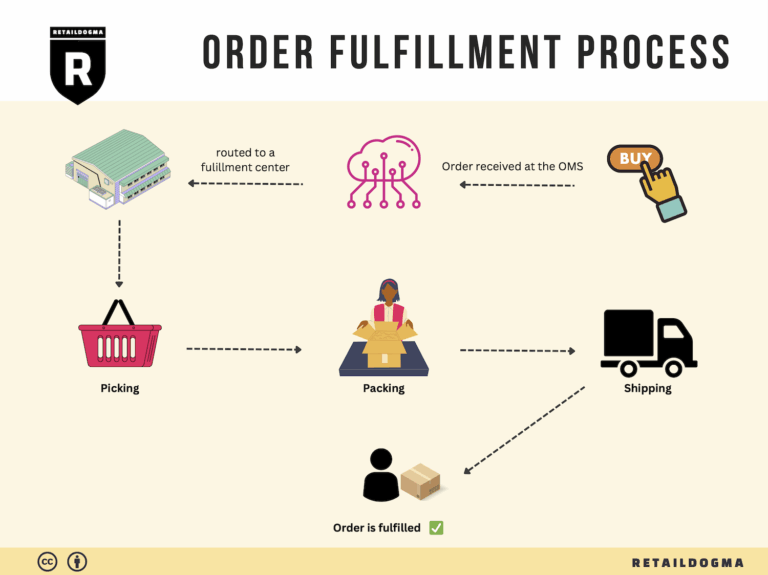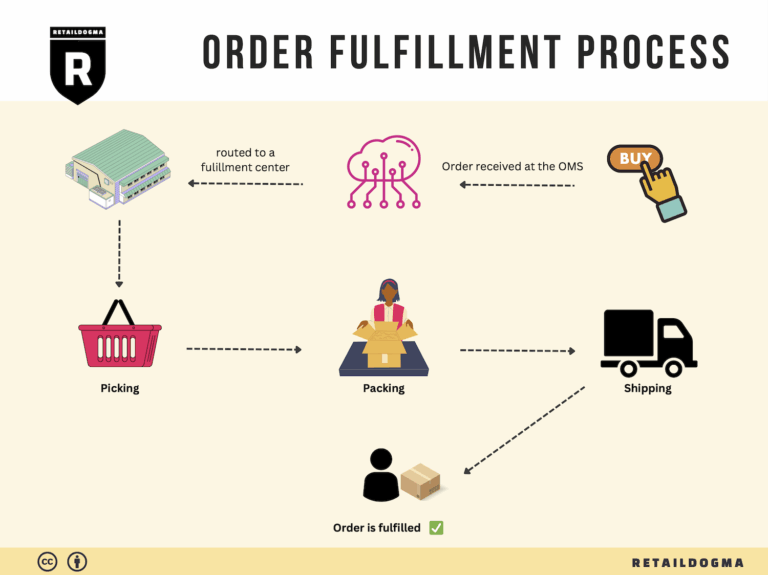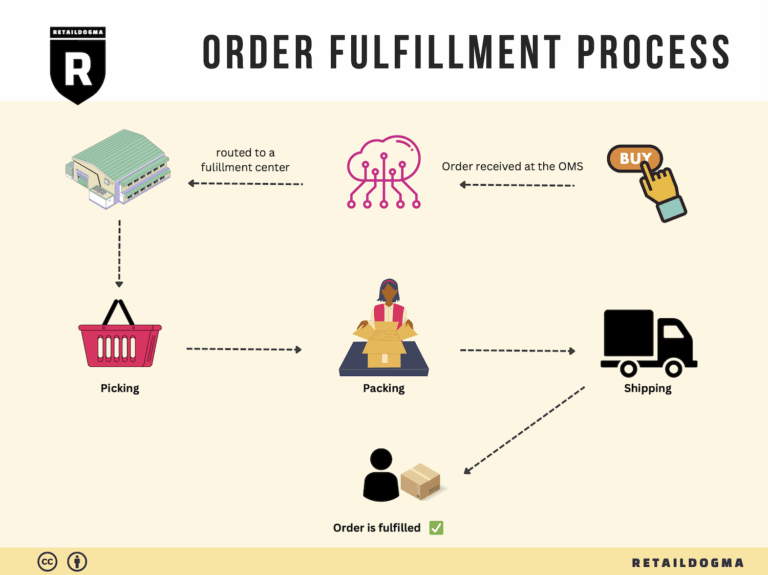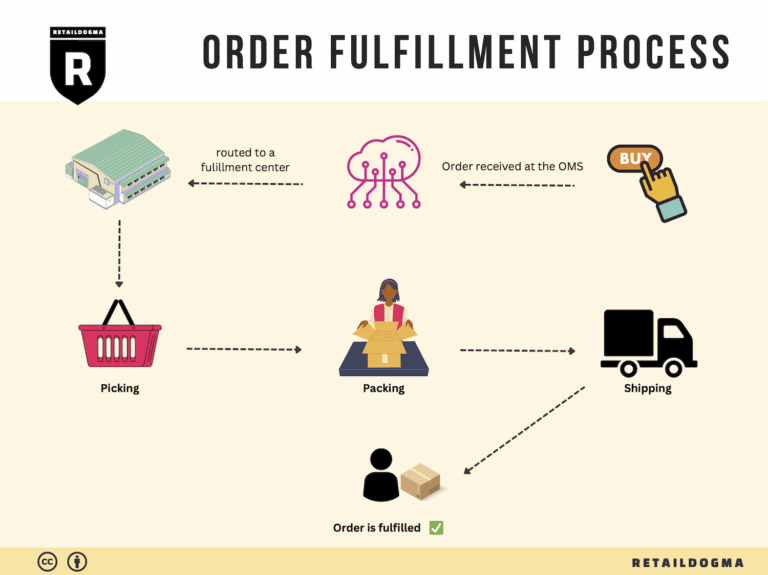How Order Fulfillment Works: A Step-by-Step Guide for Businesses
What is E-commerce Fulfillment? An Introduction for Growing Businesses
As an e-commerce business owner, you might often find yourself grappling with the complexities of packing and shipping orders. The excitement of growing sales can quickly turn into overwhelm as you face the logistical challenges of fulfilling customer demands efficiently. This is where e-commerce fulfillment comes into play—a crucial process that ensures your products reach customers promptly and accurately.
Understanding E-commerce Fulfillment
At its core, e-commerce fulfillment is the process of receiving, processing, and delivering orders to customers. This process encompasses everything from inventory management and order processing to packing and shipping. As your business scales, having a streamlined fulfillment strategy becomes vital to maintaining customer satisfaction and loyalty.
In this guide, we will explore various fulfillment models, including third-party logistics (3PL) and Fulfillment by Amazon (FBA), both of which offer distinct advantages depending on your business needs. Understanding these models will help you determine the best fit for your operations.
Core Services of Fulfillment
We will also delve into the essential services involved in e-commerce fulfillment. This includes inventory management, order processing, packing, shipping, and handling returns. Each of these components plays a significant role in delivering a seamless customer experience, which is increasingly vital in today’s competitive landscape.
Choosing the Right Fulfillment Partner
Selecting the right fulfillment partner is another critical aspect we’ll cover. With numerous options available, understanding what to look for in a partner—such as reliability, technology integration, and scalability—can significantly impact your business’s operational efficiency.
Pricing Considerations
Finally, we will address pricing strategies associated with e-commerce fulfillment. Understanding the costs involved, from storage fees to shipping rates, will empower you to make informed decisions that align with your budget while maximizing profitability.
Empowering Smart Decisions
The goal of this guide is to empower you, the growing business owner, to make informed and strategic decisions about your logistics. By understanding the intricacies of e-commerce fulfillment, you can position your business for sustained growth and enhanced customer satisfaction, ultimately leading to long-term success in the e-commerce landscape.
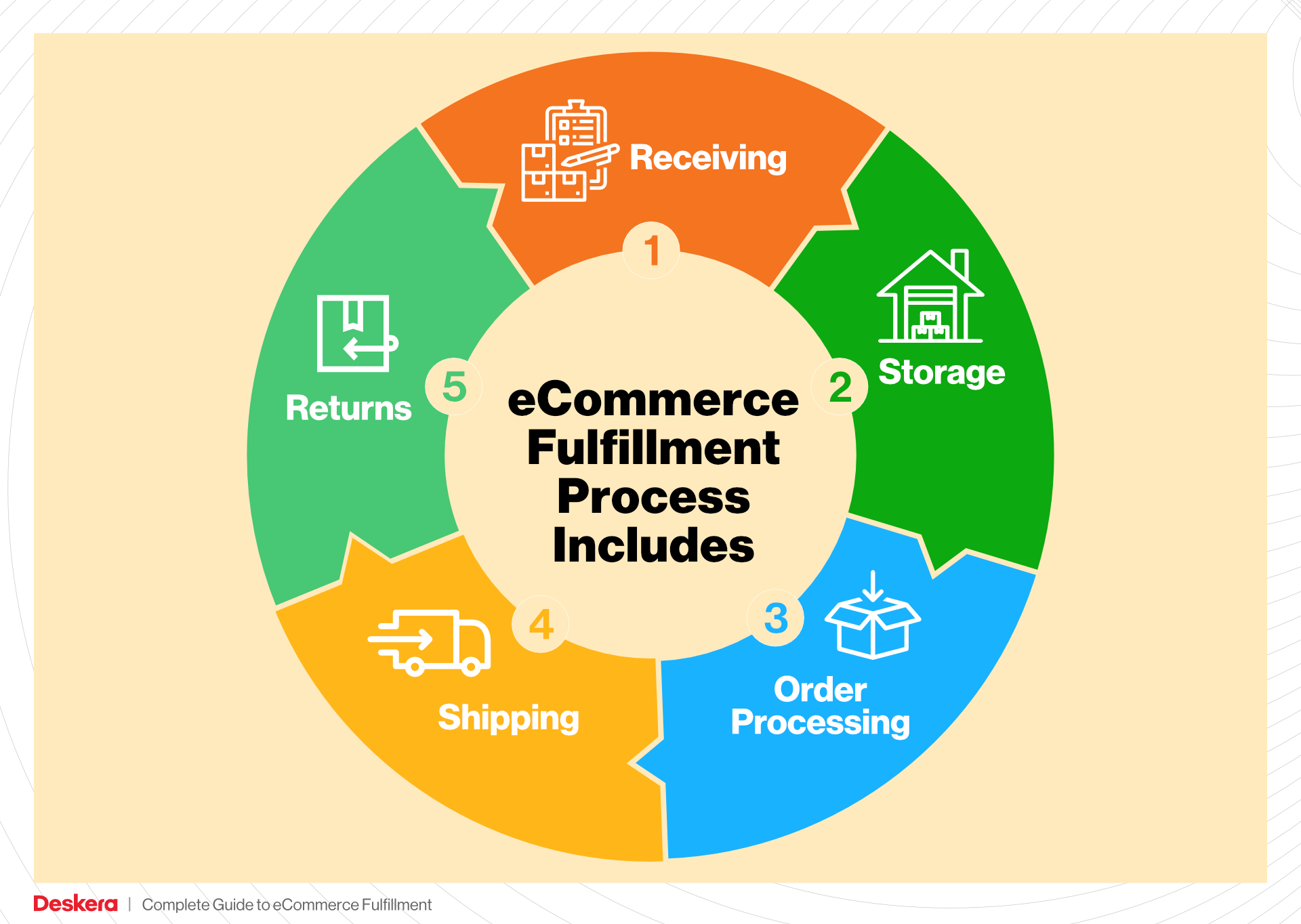
What You’ll Learn In This Guide
- What is E-commerce Fulfillment? An Introduction for Growing Businesses
- The Order Fulfillment Process: From ‘Buy’ Button to Customer’s Door
- Comparing Fulfillment Models: In-House vs. 3PL vs. Dropshipping
- A Deep Dive into Amazon FBA: Pros, Cons, and Who It’s For
- Core Services Offered by Fulfillment Centers
- How to Choose a Fulfillment Partner: A 6-Point Checklist
- Understanding Fulfillment Pricing: A Breakdown of Common Fees
- Frequently Asked Questions (FAQs) about Fulfillment
- Conclusion: Is Outsourcing Fulfillment the Right Move for Your Business?
- Important Disclaimer
The Order Fulfillment Process: From ‘Buy’ Button to Customer’s Door
1. Receiving Inventory
The order fulfillment process begins with receiving inventory, a crucial first step that sets the foundation for efficient operations. During this stage, products are delivered to your warehouse or fulfillment center, where they are inspected for quality and accuracy against the purchase order. This process involves checking the quantities received and ensuring that the correct items have arrived.
Importance: Properly receiving inventory is essential to prevent discrepancies that can lead to stockouts or overstock situations. An accurate receiving process also helps in maintaining a reliable inventory management system, which is vital for meeting customer expectations regarding product availability.
Key Term: SKU (Stock Keeping Unit) – This unique identifier for each product helps streamline the receiving process by allowing staff to quickly check items against the order list, ensuring that all products are accounted for and properly categorized in the inventory system.
2. Warehouse Storage
Once inventory has been received and verified, the next step is warehouse storage. Efficient storage solutions are critical for maximizing space and ensuring quick access to products. Items are organized systematically, often by category, size, or frequency of sale, to facilitate easy retrieval.
Importance: Effective warehouse storage minimizes the time spent locating items, thus enhancing overall operational efficiency. A well-structured storage system can also reduce the risk of errors during order picking and packing, directly impacting customer satisfaction.
Key Term: FIFO (First In, First Out) – This inventory management strategy ensures that older stock is sold before newer stock, helping to reduce spoilage and ensure that customers receive the freshest products possible.
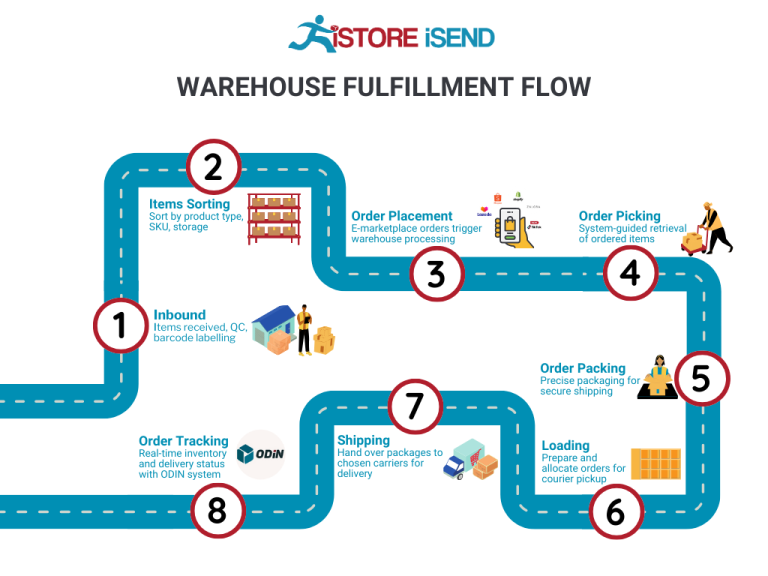
3. Order Picking
The order picking stage is where the actual fulfillment of customer orders begins. Once a customer places an order, warehouse staff utilize pick lists—documents that outline the items to be collected—to gather the required products from their respective storage locations.
Importance: This step is critical as it directly affects order accuracy and speed. Efficient picking processes reduce the time taken to fulfill orders, which is essential in today’s fast-paced e-commerce environment where consumers expect rapid delivery.
Key Term: Pick Lists – These lists guide warehouse staff in locating and gathering items for orders. They can be generated manually or through automated systems, depending on the complexity and scale of operations.
4. Order Packing
After items have been picked, the next step is order packing. During this stage, products are securely packed into boxes or envelopes, taking care to protect them during transit. This process may involve adding packing materials, labeling, and generating shipping documents.
Importance: Proper packing is crucial for ensuring that items arrive at the customer’s door in pristine condition. It also plays a significant role in minimizing returns due to damage. Moreover, thoughtful packing can enhance the unboxing experience, contributing to customer satisfaction and brand loyalty.
Key Term: Packaging Materials – These include boxes, bubble wrap, and tape, which are essential for protecting items during shipping. Choosing the right packaging materials can also help in optimizing shipping costs and sustainability practices.
5. Shipping & Delivery
The final step in the order fulfillment process is shipping and delivery. Once an order is packed, it is handed over to a carrier for transportation to the customer’s address. This stage includes choosing the appropriate shipping method based on factors such as cost, speed, and destination.

Importance: Timely and reliable delivery is the cornerstone of customer satisfaction in e-commerce. Customers today expect their orders to arrive quickly and in perfect condition. A robust shipping strategy not only meets these expectations but can also differentiate your business in a competitive market.
Key Term: Last-Mile Delivery – This term refers to the final step of the shipping process, where the package is delivered from a distribution center to the end customer. Efficient last-mile delivery solutions are vital for enhancing the overall customer experience and can involve various methods, including traditional carriers and local courier services.
By understanding and optimizing each of these five steps in the order fulfillment process, e-commerce businesses can significantly enhance operational efficiency, improve customer satisfaction, and ultimately drive growth. Embracing an integrated omnichannel fulfillment strategy that synchronizes these processes is key to thriving in today’s dynamic retail environment.
Comparing Fulfillment Models: In-House vs. 3PL vs. Dropshipping
Fulfillment Model Comparison
| Model | Who Handles Inventory | Best For (Business Stage) | Key Advantage | Key Disadvantage |
|---|---|---|---|---|
| In-House Fulfillment | Business (Own Team) | Established Businesses | Full control over operations | High overhead costs |
| Third-Party Logistics (3PL) | 3PL Provider | Growth Stage | Scalability and flexibility | Less control over inventory |
| Dropshipping | Supplier/Vendor | Startups/Small Businesses | Low upfront investment | Lower profit margins |
In-House Fulfillment
In-house fulfillment refers to managing the entire order fulfillment process within your own facilities and by your own team. This model allows businesses to maintain complete control over inventory management, order processing, and shipping operations. It is particularly beneficial for established businesses with sufficient resources, as they can tailor their fulfillment processes to align perfectly with their brand standards and customer expectations. However, this model comes with significant overhead costs, including warehousing, staffing, and technology investments. Additionally, as order volumes fluctuate, the operational complexity can increase, making it challenging to scale quickly. For businesses aiming for a high level of customization and brand experience, in-house fulfillment can be a strong choice, but they must be prepared to manage the associated costs and operational demands.
Third-Party Logistics (3PL)
Third-party logistics (3PL) is a model where businesses outsource their logistics and fulfillment operations to specialized providers. These companies manage inventory, warehousing, order processing, and shipping on behalf of the business. This model is ideal for businesses in the growth stage that need to scale their operations rapidly without the burden of expanding their own facilities. One of the primary advantages of using a 3PL is the flexibility and scalability it offers; businesses can easily adjust their logistics capabilities in response to changing market conditions or seasonal demand without significant investments in infrastructure. However, the downside is that businesses have less control over their inventory and fulfillment processes, which can lead to inconsistencies in customer service if the 3PL provider does not meet expectations. For many businesses, partnering with a reliable 3PL can lead to improved efficiency and focus on core competencies, allowing them to invest more in marketing and product development.
Dropshipping
Dropshipping is a fulfillment model in which the retailer does not hold inventory but instead relies on suppliers to fulfill orders directly to customers. When a customer makes a purchase, the retailer forwards the order details to the supplier, who then ships the product directly to the customer. This model is particularly appealing for startups and small businesses due to its low upfront investment and minimal risk. Retailers can offer a wide range of products without the financial burden of stocking inventory. However, dropshipping often comes with lower profit margins, as suppliers typically charge higher prices for the convenience of handling fulfillment. Additionally, because the retailer does not manage inventory, they may face challenges regarding product quality, shipping times, and customer service, which can impact brand reputation. For entrepreneurs looking to enter the e-commerce space with limited resources, dropshipping can be a viable option, provided they carefully select reliable suppliers and manage customer expectations effectively.
A Deep Dive into Amazon FBA: Pros, Cons, and Who It’s For
Understanding Fulfillment by Amazon (FBA)
Fulfillment by Amazon (FBA) is a service offered by Amazon that allows sellers to store their products in Amazon’s fulfillment centers. Amazon takes care of storage, packaging, and shipping, allowing sellers to focus on growing their businesses. When a customer makes a purchase, Amazon handles the entire fulfillment process, including customer service and returns. This service has become increasingly popular among e-commerce businesses, providing a way to leverage Amazon’s extensive logistics network and customer base.
How FBA Works
-
Setting Up: Sellers create an Amazon seller account and list their products on the platform. During this process, they can choose to enroll in FBA.
-
Shipping Products: Once enrolled, sellers ship their products to Amazon’s fulfillment centers. Amazon provides guidelines on how to prepare and package items to meet their standards.
-
Storage and Inventory Management: Amazon stores the products in their warehouses. Sellers can monitor their inventory levels through their seller dashboard, which provides real-time updates.
-
Order Fulfillment: When a customer places an order, Amazon picks, packs, and ships the product directly to the customer. This process often includes Amazon’s trademark fast shipping options, such as Prime two-day shipping.
-
Customer Service and Returns: Amazon handles all customer inquiries and return requests, providing a seamless experience for both sellers and buyers.
-
Payment: After an order is fulfilled, Amazon deposits the sales revenue into the seller’s account, minus any applicable fees.
Pros of Using FBA
-
Prime Eligibility: One of the most significant advantages of FBA is that products become eligible for Amazon Prime. This access to millions of Prime members can significantly boost sales, as Prime members often prefer to shop for items that qualify for free and fast shipping.
-
Customer Trust: Selling through FBA enhances customer trust. Buyers are more likely to purchase items that are fulfilled by Amazon due to the company’s reputation for reliability and customer service. This trust can lead to higher conversion rates and repeat customers.
-
Multi-Channel Fulfillment: FBA allows sellers to fulfill orders from multiple sales channels, not just Amazon. This means that if a seller has their own website or sells on other platforms (like eBay or Walmart), they can use Amazon’s fulfillment services for those orders as well, streamlining logistics and inventory management.
-
Time Savings: By outsourcing fulfillment to Amazon, sellers can free up valuable time and resources. This allows them to focus on other critical areas of their business, such as marketing, product development, and customer engagement.
-
Scalability: FBA is designed to scale with your business. As sales increase, sellers can easily send more inventory to Amazon without needing to invest in additional warehousing or logistics infrastructure.
-
Comprehensive Analytics: Amazon provides sellers with detailed analytics and reporting tools. This allows sellers to track sales trends, inventory levels, and customer behavior, enabling data-driven decision-making.
Cons of Using FBA
-
High Fees: FBA comes with various fees that can add up quickly. Sellers pay for storage space, fulfillment, and additional services like returns processing. These costs can significantly cut into profit margins, especially for lower-priced items.
-
Strict Inventory Rules: Amazon has strict guidelines for inventory management, including how products should be packaged and labeled. Sellers must adhere to these rules to avoid penalties or even removal from the platform.
-
Commingling Risks: FBA products may be commingled with those of other sellers. This means that if a seller sends in a defective product, it could affect their seller rating and customer reviews. Although Amazon has implemented measures to mitigate this risk, it remains a concern for many sellers.
-
Limited Control Over Fulfillment: When using FBA, sellers relinquish control over the fulfillment process. This can lead to issues like shipping delays or incorrect order fulfillment, which may harm the seller’s reputation.
-
Inventory Management Challenges: Managing inventory across multiple platforms can become complex. Sellers must ensure that their stock levels are appropriately adjusted to avoid overstocking or stockouts, which can lead to lost sales.
-
Seasonal Demand Fluctuations: Sellers may face challenges during peak seasons, such as the holidays. Increased demand can lead to inventory shortages or delayed shipments, which can affect customer satisfaction.
Who is FBA Best For?
Fulfillment by Amazon is best suited for e-commerce businesses looking to scale quickly and leverage Amazon’s vast logistics network. It is particularly advantageous for:
-
Small to Medium-Sized Businesses: Companies without the resources to manage their own warehousing and logistics can benefit from the efficiency and reach of FBA.
-
New Sellers: Entrepreneurs entering the e-commerce space can use FBA to reduce the burden of logistics and focus on marketing and sales.
-
Brands with High Turnover Products: Sellers with fast-moving consumer goods that require quick shipping can maximize their sales potential by using FBA.
-
Sellers Looking to Access Prime Customers: Brands aiming to tap into the large base of Amazon Prime members will find FBA an essential tool for increasing visibility and sales.
In conclusion, while Fulfillment by Amazon offers numerous benefits, including access to Prime customers and increased efficiency, potential sellers must weigh these advantages against the associated costs and challenges. Understanding how FBA fits into your overall business strategy is crucial for making an informed decision.
Core Services Offered by Fulfillment Centers
Inventory Management & Warehousing
Inventory management and warehousing are foundational services provided by fulfillment centers, essential for ensuring that e-commerce businesses operate efficiently. This service involves the systematic control of stock levels, storage, and order fulfillment processes.
What It Is: Fulfillment centers utilize advanced inventory management systems to track product quantities, locations, and movements in real-time. This includes maintaining optimal stock levels to prevent overstocking or stockouts, which can lead to lost sales or increased holding costs. Warehousing services provide a physical space where products are stored until they are needed for shipment.
Benefits to E-commerce Businesses:
1. Enhanced Visibility: Real-time inventory tracking allows businesses to monitor stock levels across multiple sales channels, ensuring they can meet customer demands promptly.
2. Cost Efficiency: By leveraging bulk storage and inventory optimization techniques, businesses can reduce storage costs while maximizing space utilization.
3. Scalability: As e-commerce businesses grow, fulfillment centers can easily adjust their warehousing capacities to accommodate increased inventory needs without the hassle of relocating or expanding physical spaces.
4. Data-Driven Insights: Comprehensive inventory management systems provide valuable analytics, enabling businesses to make informed decisions about purchasing, sales forecasting, and inventory turnover.
Pick and Pack Services
Pick and pack services refer to the process of selecting products from inventory and packaging them for shipment. This service is crucial in ensuring orders are fulfilled accurately and efficiently.
What It Is: In a fulfillment center, the pick and pack process typically involves staff or automated systems retrieving ordered items from storage, packing them according to specific guidelines, and preparing them for dispatch. This can include labeling, boxing, and ensuring that items are secure for transit.
Benefits to E-commerce Businesses:
1. Accuracy: Professional pick and pack services significantly reduce human errors, ensuring that the right products are sent to the right customers, which boosts customer satisfaction and loyalty.
2. Speed: Efficient pick and pack operations can dramatically reduce order processing times, enabling businesses to meet the high expectations of fast delivery demanded by modern consumers.
3. Customization: Fulfillment centers often offer customized packing options, including branded packaging and gift wrapping, which enhance the unboxing experience and strengthen brand identity.
4. Scalability: As order volumes fluctuate, fulfillment centers can quickly adapt their pick and pack operations, allowing businesses to scale up or down without needing to invest in additional resources.
Kitting and Assembly
Kitting and assembly involve combining multiple products into a single package or preparing items for sale in a specific configuration. This service is particularly beneficial for businesses offering bundled products or customized kits.
What It Is: Fulfillment centers can assemble kits based on specific customer orders or pre-defined configurations. This can include anything from assembling gift baskets to creating subscription boxes that contain curated items.
Benefits to E-commerce Businesses:
1. Increased Sales Opportunities: Kitting allows businesses to create value-added products that can attract customers, such as promotional bundles or themed kits, which often result in higher average order values.
2. Streamlined Operations: By outsourcing kitting and assembly, businesses can reduce the complexity of their in-house operations, freeing up time and resources to focus on core business activities such as marketing and product development.
3. Improved Customer Experience: Custom kits can enhance the customer experience by offering unique product combinations, making it easier for customers to find what they need without having to purchase items separately.
4. Inventory Management: Kitting helps in managing inventory more effectively by consolidating multiple SKUs into one, simplifying tracking and reducing the risk of stockouts on individual items.
Returns Management (Reverse Logistics)
Returns management, also known as reverse logistics, is the process of handling returned products. This service is vital for maintaining customer satisfaction and managing inventory effectively.
What It Is: Fulfillment centers manage the entire returns process, from accepting returned items to inspecting, restocking, or disposing of them as necessary. This service includes providing customers with return shipping labels, processing refunds, and managing inventory adjustments.
Benefits to E-commerce Businesses:
1. Enhanced Customer Satisfaction: A streamlined returns process can significantly improve customer satisfaction, as consumers appreciate a hassle-free way to return products that don’t meet their expectations.
2. Cost Control: Efficient returns management helps businesses minimize losses associated with returned products by quickly restocking items that can be resold and reducing the costs associated with reverse logistics.
3. Data Insights: Analyzing return data can provide valuable insights into product quality, customer preferences, and potential issues, enabling businesses to make informed decisions about product offerings and marketing strategies.
4. Brand Loyalty: A positive returns experience can enhance brand loyalty, as satisfied customers are more likely to make repeat purchases and recommend the brand to others.
By leveraging these core services offered by fulfillment centers, e-commerce businesses can streamline their operations, enhance customer satisfaction, and ultimately drive growth in a competitive marketplace.
How to Choose a Fulfillment Partner: A 6-Point Checklist
Location & Warehouse Network
Importance: The geographical location of a fulfillment partner significantly affects shipping times and costs. A strategically located warehouse network can reduce transit times and improve delivery speed, which is crucial for customer satisfaction.
Questions to Ask:
– Where are your warehouses located, and how does that align with our target market?
– Do you have the ability to open additional locations if our business expands?
– How do you handle shipping to international locations, if applicable?
Technology & Integrations
Importance: An effective fulfillment partner must utilize advanced technology to provide real-time inventory visibility, streamline operations, and integrate seamlessly with your existing e-commerce platforms. This ensures a smooth flow of information and minimizes errors.
Questions to Ask:
– What order management system do you use, and how does it integrate with popular e-commerce platforms?
– Can your technology support real-time tracking for both inventory and shipments?
– How often do you update your technology, and what innovations do you have planned for the future?
Specializations (e.g., cold storage, oversized items)
Importance: Depending on your product offerings, you may require specific capabilities from your fulfillment partner. Whether it’s temperature-controlled storage for perishables or special handling for oversized items, ensuring the partner can accommodate your unique needs is vital.
Questions to Ask:
– What types of products do you specialize in, and do you have the necessary facilities for our product types?
– How do you handle products that require special storage conditions (e.g., cold storage, hazardous materials)?
– Can you manage custom packaging or kitting for our products if needed?
Scalability & Capacity
Importance: As your business grows, your fulfillment partner must be able to scale operations to meet increased demand. A partner that can handle fluctuations in order volume without compromising service quality is essential for long-term success.
Questions to Ask:
– What is your maximum capacity for order fulfillment, and how do you manage peak seasons?
– Can you provide examples of how you’ve successfully scaled operations for other clients?
– How flexible are your services in adapting to sudden increases or decreases in inventory levels?
Pricing and Contracts
Importance: Understanding the pricing structure and contract terms is crucial to avoid unexpected costs. Transparent pricing can help you budget effectively and ensure that your fulfillment expenses align with your business growth.
Questions to Ask:
– Can you provide a detailed breakdown of your pricing model, including any hidden fees?
– What is your policy on contract length and termination? Are there any penalties for early termination?
– How do you handle pricing adjustments, especially in the case of fluctuating shipping rates?
Customer Support & Reviews
Importance: Reliable customer support is essential for resolving issues quickly and maintaining smooth operations. Additionally, reviewing feedback from current or past clients can provide insights into the partner’s reliability and performance.
Questions to Ask:
– What customer support channels do you offer (e.g., phone, email, chat), and what are your response times?
– Can you share references or case studies from current clients in similar industries?
– How do you handle disputes or issues related to order fulfillment?
Conclusion
Choosing the right fulfillment partner is a critical decision that can significantly impact your business’s efficiency, customer satisfaction, and overall success. By carefully evaluating each of these six key areas, you can ensure that your partner not only meets your current needs but is also equipped to support your growth in the future. Use this checklist as a guide to facilitate discussions with potential partners and make an informed decision that aligns with your business goals.
Understanding Fulfillment Pricing: A Breakdown of Common Fees
Initial Setup Fees
Initial setup fees are the costs associated with establishing your account with a fulfillment provider. This fee often covers the onboarding process, which may include the integration of your e-commerce platform with the fulfillment center, setting up inventory management systems, and customizing your fulfillment processes to align with your business needs.
The calculation of initial setup fees can vary significantly based on the complexity of your requirements. For example, if your business needs custom software integration or advanced reporting features, expect higher fees. Typically, you might see a one-time charge ranging from a few hundred to several thousand dollars. Always clarify what is included in this fee to avoid surprises later.
Receiving Fees
Receiving fees are charged when your inventory arrives at the fulfillment center. This fee compensates the warehouse for the labor and resources required to unload, inspect, and properly store your products.
Receiving fees are usually calculated based on the number of units received or the total weight of the shipment. Some providers may charge a flat rate per pallet or bin as well. For instance, if you send 100 boxes of product, the fulfillment center might charge a rate of $0.25 per box or $15 per pallet. Understanding this fee is crucial, as it can add up quickly depending on your shipping frequency and volume.
Storage Fees (per pallet/bin)
Storage fees are recurring charges for holding your inventory in the fulfillment center. These fees can be calculated on a monthly basis and typically depend on the volume of space your products occupy, often measured in pallets or bins.
Common pricing structures include a fixed monthly rate per pallet, ranging from $15 to $50, or a fee per cubic foot. Some fulfillment centers may also implement tiered pricing, where the cost per pallet decreases as you store more units. Be mindful of your inventory turnover rate, as high storage fees can eat into your profit margins if products remain unsold for extended periods.
Pick & Pack Fees (per item/order)
Pick and pack fees are charged for the labor involved in selecting items from your inventory and preparing them for shipment. This process includes picking the correct products, packing them securely, and labeling them for delivery.
Typically, pick and pack fees are calculated per item or per order. For instance, a fulfillment provider might charge $1.00 per item picked and packed, or a flat rate of $2.50 per order, regardless of the number of items included. Understanding the nuances of this fee structure is essential, especially if your product range varies widely in size and weight, as it can significantly impact your overall fulfillment costs.
Shipping Fees
Shipping fees are the charges incurred when your products are dispatched to customers. These fees can vary based on several factors, including the shipping method chosen (e.g., standard, expedited), the destination, the weight and dimensions of the package, and the carrier used.
Shipping fees may be calculated using flat-rate pricing, where a set amount is charged for different weight brackets, or variable pricing based on real-time rates from carriers like UPS, FedEx, or USPS. It’s vital to negotiate shipping rates with your fulfillment provider, as they often have partnerships that can yield better rates than what you might secure independently. Additionally, understanding the different shipping options available can help you provide better service to your customers while managing costs effectively.
Tips for Getting an Accurate Quote
-
Be Transparent About Your Needs: Provide potential fulfillment partners with detailed information about your product types, order volumes, and shipping frequency. This transparency helps them offer a tailored quote that reflects your specific needs.
-
Compare Multiple Providers: Don’t settle for the first quote you receive. Comparing several fulfillment centers will give you a broader perspective on pricing structures and service offerings.
-
Ask About Hidden Fees: Ensure you inquire about any potential hidden fees that may not be included in the initial quote, such as returns processing, special handling, or seasonal rate increases.
-
Understand Your Growth Potential: If you anticipate significant growth, discuss potential volume discounts or rate adjustments with fulfillment providers. Some may offer lower rates as your order volume increases.
-
Request a Trial Period: If feasible, negotiate a trial period to assess the fulfillment service’s efficiency and accuracy before committing to a long-term contract. This can help you better understand the true costs and quality of service.
By understanding these common fulfillment pricing models and following these tips, you can make informed decisions that align with your business goals and enhance your overall operational efficiency.
Frequently Asked Questions (FAQs) about Fulfillment
1. What is omnichannel fulfillment?
Omnichannel fulfillment is a strategy that integrates various sales channels—such as online stores, physical locations, and marketplaces—into a unified inventory and order management system. This approach allows businesses to streamline their fulfillment processes, ensuring that customers receive consistent service and accurate product availability, regardless of the channel through which they purchase.
2. How does omnichannel fulfillment differ from multichannel fulfillment?
While both strategies involve selling through multiple channels, multichannel fulfillment typically manages inventory separately for each channel, leading to potential inefficiencies. In contrast, omnichannel fulfillment uses a unified inventory system, allowing businesses to allocate stock across channels more effectively and respond quickly to demand fluctuations.
3. What are the benefits of adopting an omnichannel fulfillment strategy?
Implementing an omnichannel fulfillment strategy offers several benefits, including:
– Greater order efficiency and accuracy
– Enhanced customer satisfaction through improved service
– Increased sales and revenue due to better product availability
– Extended brand exposure by reaching consumers on multiple platforms
– Real-time reporting and analytics for better decision-making
4. What is a fulfillment center?
A fulfillment center is a specialized warehouse designed to handle the storage, packing, and shipping of products for e-commerce businesses. Unlike traditional warehouses, which may focus solely on storage, fulfillment centers prioritize fast and accurate order processing to meet the demands of online shoppers.
5. What is a 3PL (Third-Party Logistics)?
A 3PL, or third-party logistics provider, is a company that offers outsourced logistics services, including warehousing, inventory management, order fulfillment, and shipping. By partnering with a 3PL, businesses can scale their operations without the need to invest in their own logistics infrastructure, allowing them to focus on core activities like marketing and product development.
6. How much do fulfillment services cost?
The cost of fulfillment services can vary widely based on factors such as order volume, storage space required, and additional services like packaging and returns management. Typically, businesses can expect to pay for storage fees (per pallet or cubic foot), picking and packing fees (per order or item), and shipping costs. It’s essential to compare different providers and their pricing structures to find a solution that fits your budget and needs.
7. How can I improve my omnichannel fulfillment processes?
To enhance your omnichannel fulfillment, consider the following strategies:
– Implement a unified inventory management system for real-time visibility across channels.
– Automate order processing to reduce errors and speed up fulfillment.
– Utilize data analytics to understand customer preferences and optimize stock levels.
– Offer flexible delivery options, such as Buy Online, Pick-Up In-Store (BOPIS) and Buy Online, Return In-Store (BORIS).
8. What technologies are essential for effective omnichannel fulfillment?
Key technologies for successful omnichannel fulfillment include:
– Inventory management software that synchronizes stock levels across all channels.
– Order management systems that streamline order processing and tracking.
– Shipping solutions that provide real-time shipping rates and delivery updates.
– Customer relationship management (CRM) tools to enhance customer engagement and service.
9. How can I ensure inventory accuracy in an omnichannel environment?
To maintain inventory accuracy, regularly audit stock levels and implement real-time inventory tracking systems. Use barcoding or RFID technology to minimize human error during stock counts, and ensure that all sales channels are updated simultaneously when orders are placed or inventory is adjusted.
10. Is omnichannel fulfillment suitable for small businesses?
Yes, omnichannel fulfillment can be highly beneficial for small businesses looking to compete in the digital marketplace. By adopting an omnichannel strategy, small businesses can enhance customer experience, improve inventory management, and increase sales opportunities without the need for significant infrastructure investment.
Conclusion: Is Outsourcing Fulfillment the Right Move for Your Business?
Evaluating the Benefits of Outsourcing Fulfillment
As you consider the landscape of omnichannel fulfillment, outsourcing your logistics can emerge as a strategic move that offers numerous advantages. By leveraging a fulfillment service, your business can save valuable time and resources, allowing you to focus on core operations such as product development, marketing, and customer engagement. This efficiency is crucial in a fast-paced e-commerce environment where speed and accuracy can significantly impact customer satisfaction.
Scalability is another compelling reason to consider outsourcing. Fulfillment partners provide the infrastructure and capacity to accommodate fluctuating demand, whether you’re experiencing peak sales seasons or expanding into new markets. This flexibility ensures that your business can grow without the burden of managing extensive warehouse operations or hiring additional staff.
Moreover, partnering with a fulfillment service grants you access to industry expertise and advanced technology. These providers often have established systems for inventory management, shipping logistics, and order processing, which can enhance your operational efficiency and accuracy. By utilizing their knowledge, you can streamline your processes and improve your overall service delivery.
However, it’s essential to choose the right fulfillment partner that aligns with your business goals and customer expectations. Conduct thorough research and consider factors such as their technology stack, shipping capabilities, and customer service reputation. The right partner will not only support your current needs but also contribute to your long-term growth strategy.
Next Steps
To determine if outsourcing fulfillment is the right next step for your business, consider conducting a comprehensive audit of your current shipping processes. Evaluate your order fulfillment times, accuracy rates, and customer feedback. This assessment will help you identify pain points and opportunities for improvement, guiding you toward a fulfillment solution that can elevate your business to new heights. Embrace the potential of omnichannel fulfillment and position your brand for sustained success in the evolving e-commerce landscape.
Important Disclaimer
⚠️ Important Disclaimer
The information in this guide is for educational purposes. Fulfillment services, pricing, and platform features change frequently. Always conduct your own due diligence and consult with providers directly before making business decisions.
